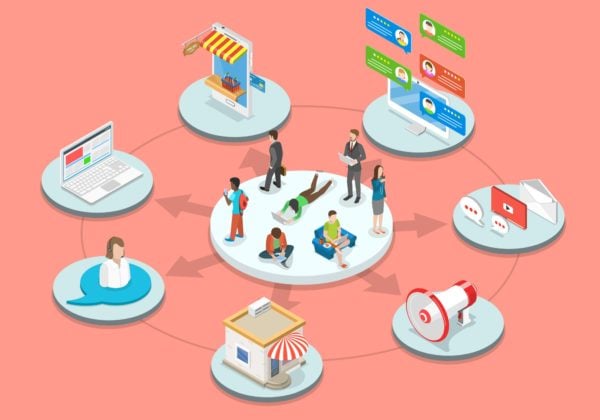Omnichannel Retail Strategy to Drive Future Order Profitability

As the COVID-19 vaccine rollout continues and the pandemic begins to stabilize, we’ll soon be entering into the next phase of retail. The number of online orders will likely decrease as stores reopen, but e-commerce sales will remain higher than pre-pandemic. The stores (and malls) that survived will become more experiential and customer focused. During this next phase we will see omnichannel retail strategy in its truest form — where customers expect nothing less than a seamless integration of physical and digital experiences.
Moving forward, traditional retailers are faced with both an opportunity and a threat. The opportunity lies in the assumption that shoppers will crave the in-person shopping experience and brick-and-mortar retailers will be ready and waiting to welcome them back with open arms. The threat lies in the assumption that since online adoption has increased, consumers have settled into purchasing habits and buying patterns that favor pure-play online retailers that offer wide product selection, low pricing and free, fast delivery (Amazon) and/or omnichannel players who have cracked the omnichannel code and offer a wide product selection, low pricing and free, fast delivery (Walmart, Target).
The scales are tipped in favor of these retailers due to their purchasing power, reach and cash on hand to drive category dominance. So, what’s a traditional retailer to do?
Three Omnichannel Retail Strategies to Drive Your Future Order Profitability
1. Build Your Brand Across All Channels
Retailers need to embrace what makes them unique in the marketplace and what drives customer loyalty. Invest in marketing your brand, engaging with your customers and acquiring new customers based on your value proposition and not on price or delivery speed, which will insulate you from race-to-the-bottom promotions.
If you are a fashion retailer, this brand mentality is already embedded into your core and you’ll have an easier time building your value. Unfortunately, if you are a retailer in durable consumer goods — toys, consumer electronics, appliances, etc. from manufacturers — you will have a tougher time in this environment of product commoditization. You may need to pivot to private label manufacturing while also building customer loyalty to the store, potentially with loyalty programs, enriched customer experiences and corporate values.
Through these practices, retailers will be able to demand a premium for their goods (for strong brands) or at least stay in the game (for consumer goods). Nonetheless, you will still need to extract every ounce of profitability from your orders. This may require you to find cost-savings through supply chain efficiencies.
2. Implement Cost-cutting Fulfillment Strategies
In previous blog posts, I’ve described ways that distributed order management can help retailers optimize inventory and supply chain nodes, but also reduce delivery costs through flexible order fulfillment strategies and curbside pickup. These fulfillment strategies have gained in adoption throughout the pandemic and will continue to do so as omnichannel retail strategy becomes the standard model.
One area that remains an Achilles’ heel for retailers, especially those considering a true micro-fulfillment (store as warehouse) strategy, is labor planning and labor cost. As stores reopen and customers flood in, a store acting as a micro-fulfillment center will need to efficiently manage store traffic and order volumes. If there are too many customers in-store and not enough staff on the floor, then customer experience suffers and your brand will be negatively impacted. On the flip side, if order volumes peak while employees are busy dealing with store staff, then the online experience suffers, the service level agreement (SLA) breaks and your brand will be negatively impacted.
The short-term solution to labor planning and labor costs in-stores is effective store management, forecasting and process training. To compete with the market leaders (Amazon), retail stores will need to turn to automation technology. Note, not all stores will be able to implement micro-fulfillment automation technology due to the footprint required. However, big-box stores selling commoditized consumer goods would do well to consider converting their back stores into fully automated fulfillment centers, which in the short term would increase processing and delivery times and in the long term, eliminate variable fulfillment labor costs.
3. Make Data-driven Decisions
To compete in a true omnichannel environment, retailers can no longer “set it and forget it.” You need to be analyzing your customer data on store traffic, e-commerce site traffic and social media engagement. Then there is the fulfillment data on store and warehouse inventory levels along with the order management data regarding order sizes, cart abandonments and shipping methods. All these data points need to be consistently monitored and tweaked to drive sales and profitability.
For example, it might be time to review your minimum order size that qualifies for free shipping. If the order size was taken from historical data, it may no longer be relevant due to recent shifts in customer behaviors. Or your fulfillment/delivery costs for one geographic region may be lower than other regions, therefore, margins are higher. You’ll want to analyze this data to determine if your minimum order should be adjusted to account for this. Another scenario is when an influencer is trending and an item he/she promoted is flying off the shelves. You will need inventory visibility data to ensure stock across all fulfillment nodes, including stores and in-transit. Did you plan/forecast for this in advance?
The rules, policies and procedures that drive these scenarios, in addition to the supporting data, should be completely appreciated by all parts of the business and not just sit in a silo. Your omnichannel retail strategies touch so many different parts of the business at the same time — marketing and e-commerce, IT, merchandising/planning/allocation and supply chain — that regular collaboration through cross-functional teams is critical. To meet the high demands of omnichannel retail, an agile approach is recommended.
The Future is Bright
It should only be a matter of time, perhaps six to nine months, before a semblance of retail normalcy (regular store openings/hours) reappears. When this happens, the likelihood of customers being back in stores is strong. However, these customers are different now: they’re true omnichannel customers. For retailers to drive order profitability and succeed in this future, you will need to provide a strong brand experience, identify opportunities for fulfillment cost-savings and regularly monitor data and tweak different aspects of your retail omnichannel strategy.




